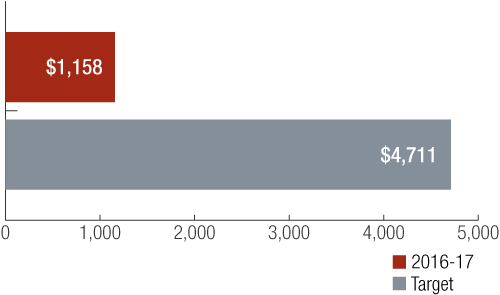KPI 7: Average weighted cost of regulatory and compliance services
What we measure:
Through an adaptive, risk-based approach to regulation and compliance, the department ensures responsible resource exploration, development and rehabilitation activities throughout the life cycle of any development, whilst maximising economic return to the state.
The department also manages the regulation of the manufacture, storage, handling, transport and use of dangerous goods, including the operation of major hazard facilities.
This indicator monitors how efficiently the department delivers regulatory and compliance services relating to health, safety and social responsibility, environment and dangerous goods to ensure resources are optimised.
How we measure:
This measure is calculated as the total cost of regulatory and compliance services divided by the number of weighted regulatory and compliance services.
| Target | Actual | Status | |||
|---|---|---|---|---|---|
| Overall results | $4,711 | $1,158 | -76% | |
Target exceeded |
KPI 7: Average weighted cost of regulatory and compliance services

Results by regulatory area:
- 2 per cent of the total result are Petroleum regulatory and compliance services.
- 10 per cent of the total result are Mineral Titles regulatory and compliance services.
- 4 per cent of the total result are Environment regulatory and compliance services.
- 82 per cent of the total result are Resource Safety regulatory and compliance services.
- 2 per cent of the total result are Royalties regulatory and compliance services.
Our performance:
The actual result is substantially lower than predicted due to changes in the overall methodology and counting rules for this indicator. Updates to weightings and classifications of activities means the results are not directly comparable to the target set.
The weightings used in the calculation of this indicator have been updated, since the target was set, to better reflect effort and improve consistency in the composite KPI counting methodology.
Overall, an increase in reported activity has resulted in a decrease in average cost of regulatory compliance services. An increase in regulatory activity was reported in all areas, with a most notable increase in Resource Safety, which represents 82 per cent of the department’s overall regulatory activity.
Environmental compliance has continued to be strengthened, with an increased focus on compliance to manage the risks of environmental harm and rehabilitation liability being transferred to the State.
Similarly, Royalties regulatory and compliance services has risen marginally to target due to more mineral projects commencing during the past year.
The primary focus for Petroleum in 2016-17 was to ensure compliance with Well Management Plans. High-risk sites were targeted for inspections, in particular those sites in the process of decommissioning wells, so that the department could be confident that wells were being appropriately plugged and decommissioned. Well integrity was also a focus, through both compliance monitoring and site inspections to witness integrity checks on wells.
Overall, the variation of efficiency is directly linked to a broader range of regulatory compliance services reported under revised methodology together with department initiated savings measures, resulting in more efficient delivery of services.
